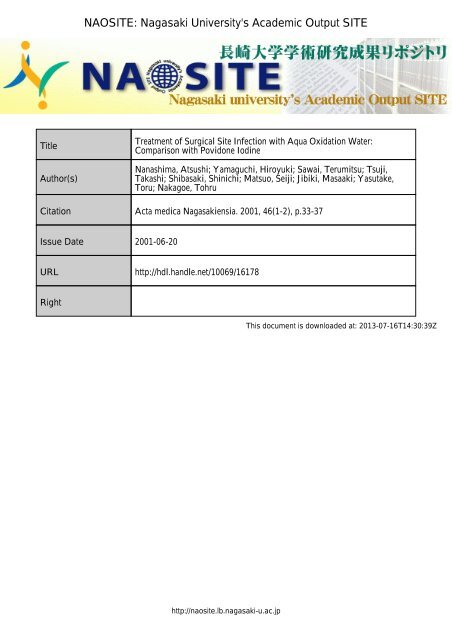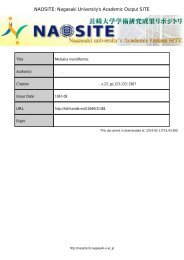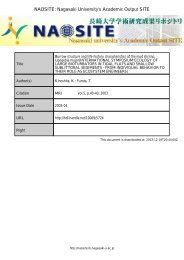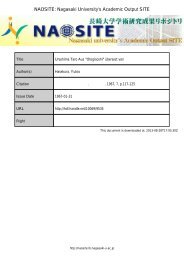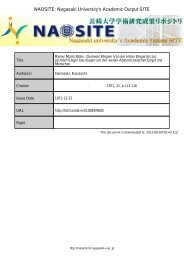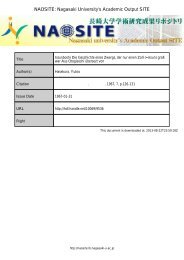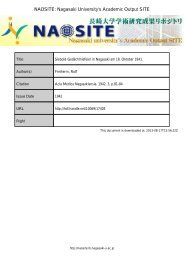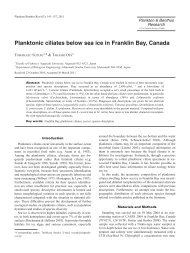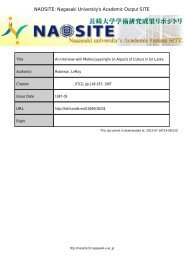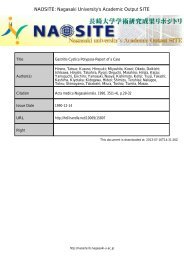Treatment of Surgical Site Infection with Aqua Oxidation Water ...
Treatment of Surgical Site Infection with Aqua Oxidation Water ...
Treatment of Surgical Site Infection with Aqua Oxidation Water ...
You also want an ePaper? Increase the reach of your titles
YUMPU automatically turns print PDFs into web optimized ePapers that Google loves.
Acta Med. Nagasaki 46 : 33-37<br />
<strong>Treatment</strong> <strong>of</strong> <strong>Surgical</strong> <strong>Site</strong> <strong>Infection</strong> <strong>with</strong> <strong>Aqua</strong> <strong>Oxidation</strong> <strong>Water</strong>:<br />
Comparison <strong>with</strong> Povidone Iodine<br />
Atsushi NANASHIMA, Hiroyuki YAMAGUCHI, Terumitsu SAWAI, Takashi Tsuji, Shinichi SHIBASAKI, Seiji MATSUO,<br />
Masaaki JIBIKI, Toru YASUTAKE, Tohru NAKAGOE, Hiroyoshi AYABE<br />
The First Department <strong>of</strong> Surgery, Nagasaki University School <strong>of</strong> Medicine<br />
<strong>Aqua</strong> oxidation water is a new disinfectant <strong>with</strong> a bacte-<br />
ricidal activity based on high oxidation-reduction potential<br />
and acidity. We compared the effectiveness <strong>of</strong> aqua oxida-<br />
tion water and povidone iodine against the surgical site in-<br />
fection (SSI). The bacteriological effect against several or-<br />
ganisms and the efficacy <strong>of</strong> both disinfectants were almost<br />
similar. However, the duration <strong>of</strong> treatment <strong>with</strong> aqua oxi-<br />
dation water was shorter than that <strong>with</strong> the povidone io-<br />
dine in healed wounds (p
trial. All operative procedures were gastrointestinal, co-<br />
lorectal and hepato-biliary-pancreas surgery and there<br />
were no significant differences between both groups.<br />
The clinical use <strong>of</strong> AOW was approved by the Humans<br />
Ethics Review Committee <strong>of</strong> our department and a<br />
signed consent form was obtained from each patient.<br />
<strong>Aqua</strong> <strong>Oxidation</strong> <strong>Water</strong><br />
The AOW was prepared from 5% NaC1 solution <strong>with</strong><br />
tap water and produced by electrolysis for approximately<br />
10 minutes using the Super Oxseed JES-010<br />
a 1000® (Amano Co., Yokohama, Japan and Shionogi<br />
& Co., Aburahi Lab., Shiga, Japan). AOW had a very<br />
low pH, ranging from 2.3 to 2.7, and the oxidationreduction<br />
potential was high ranging from 1000 to<br />
1200 mV. AOW also contained 30 ppm <strong>of</strong> free chlorine<br />
and 50 ppm <strong>of</strong> superoxide as byproducts <strong>of</strong> the electrolysis<br />
process. AOW was stored in a shielded bottle<br />
at room temperature for a week. PI (Isodine solution,<br />
Meiji Seika Co., Tokyo, Japan) was diluted to 0.02% and<br />
was also stored in a shielded bottle at room temperature.<br />
Experimental protocol<br />
Freshly prepared AOW was used for purulent wounds<br />
(pus) including surgical wounds. All patients had been<br />
treated <strong>with</strong> drainage and dressing. Most patients were<br />
given systemic antimicrobial drugs but no significant<br />
difference between groups (96% and 93%) before the<br />
use <strong>of</strong> AOW and PI, but no antibiotic or other disinfectants<br />
were applied on the infected wounds during the<br />
use <strong>of</strong> AOW and PI. <strong>Treatment</strong> <strong>of</strong> the wounds was ap-<br />
plied once daily.<br />
Assessment <strong>of</strong> treatment<br />
Following the use <strong>of</strong> AOW or PI, the degree <strong>of</strong> inflammation,<br />
the amount <strong>of</strong> purulent material, blood<br />
tests (leukocyte count and CRP), body temperature and<br />
bacterial culture were evaluated after treatment for one<br />
or two weeks and compared <strong>with</strong> pre-treatment values.<br />
The purulent materials were taken <strong>with</strong> SEEDSWAB®<br />
No. 3 (Eiken Kizai Co., Tokyo). The material was then<br />
plated on sheep blood agar, Digalski' modified agar or<br />
chocolate agar for aerobic culture, on Anaero Columbia<br />
agar for anaerobic culture, and on Sabourand agar for<br />
culture <strong>of</strong> fungus. Quantification <strong>of</strong> organisms was performed<br />
using the Spiral SystemT"' (Gunze Sangyo, Inc.,<br />
Tokyo). The bacteria isolated from the samples were<br />
identified by using Vitek Gram-Positive, Gram-Negative,<br />
or fungus Identification card (Vitek Systems, Inc.,<br />
Hazelwood, MO). In the present study, the criteria <strong>of</strong><br />
the bacteriological effectiveness was defined in case<br />
the initial organism> 106 reduced or completely disap-<br />
peared after the use <strong>of</strong> AOW or PI.<br />
The clinical effectiveness <strong>of</strong> treatment was divided<br />
into four grades; very effective, effective, no change<br />
and worse. "Very effective" represented a complete<br />
healing <strong>of</strong> the infected wound that never showed pus<br />
formation, redness and swelling, while "effective" den<br />
oted a reduction <strong>of</strong> infection but complete healing was<br />
not established. Comparisons between PI and AOW were<br />
tested for statistical differences using the Student' t-test.<br />
For differences between ratios, we used the X 2 test. A<br />
p value< 0.05 was considered significant.<br />
Results<br />
All patients were in a stable condition during the<br />
study and none refused therapy. As shown in Table I,<br />
associated disorders were similar in patients treated<br />
<strong>with</strong> AOW and PI. Three patients had diabetes (2 in<br />
AOW group and 1 in PI group). The period <strong>of</strong> use <strong>of</strong><br />
AOW varied from less than one week to more than 1<br />
month. The incidence <strong>of</strong> patients in AOW group, who<br />
treated <strong>with</strong> disinfectants for more than 30 days, was<br />
significantly less than that in PI group '(p 2.0 in 19 (41%) <strong>of</strong> AOW group and<br />
32 (76%) <strong>of</strong> PI group, but normalized in 18 and 22<br />
patients, respectively. A high body temperature (>37<br />
°C) was observed in 34 <strong>of</strong> AOW group and 34 <strong>of</strong> PI<br />
group but returned to normal in 12 and 24 patients,<br />
respectively. During the course <strong>of</strong> treatment, the laboratory<br />
tests did not worsen in those <strong>with</strong> normal values<br />
at baseline (pre-treatment). There was no significant<br />
difference in the general response between AOW<br />
and PI.<br />
Table II lists the organisms isolated from the infected<br />
wounds treated <strong>with</strong> AOW and PI, and shows<br />
the bacteriological effectiveness <strong>of</strong> AOW and PI, respectively.<br />
These included 118 bacterial species and 3 fungi.
Table 1. Comparison between the use <strong>of</strong> aqua oxidation<br />
water and povidone iodine for the treatment <strong>of</strong> surgical site<br />
infection.<br />
AOW (%) Povidone Iodine (%)<br />
n 46 42<br />
Duration <strong>of</strong> Therapy (days)<br />
0-7 14(30) 6(14)<br />
7-14 25(54) 12(29)<br />
>14 5 (11) 15(36)<br />
>30 2 ( 5) 9(21)<br />
Associated Disorders for<br />
operation:<br />
malignancy 29(63) 35 (83)<br />
IBD* 7(15) 3 ( 7)<br />
others 10(21) 4(10)<br />
Complications:<br />
none 42(91) 32(76)<br />
pain 3 ( 7) 10(24)<br />
bleeding 1 ( 2) 0 ( 0)<br />
*: IBD; inflammatory bowel disease<br />
, prednisolone was used for all patients<br />
Table 2. The bacteriological effects <strong>of</strong> aqua oxidation water<br />
and povidone iodine.<br />
Initial Organism (>10') Disappeared Reduced Persisted Total<br />
AOW PI AOW PI AOW PI AOW PI<br />
1. Actinomyces 1 0 0 0 0 0 1 0<br />
related organisms<br />
2. Gram positive cocci<br />
MRSA 3 2 2 0 2 2 7 4<br />
Other staphylococci 4 2 0 0 0 1 4 3<br />
Streptococci 7 6 0 1 2 1 9 8<br />
Others 2 5 0 3 2 3 3 11<br />
3. Gram-negative bacteria:<br />
P. aeruginosa 3 6 3 1 4 3 10 10<br />
E. colt 2 2 3 1 2 0 7 3<br />
B. fi•agilis 3 1 1 0 1 1 5 2<br />
E. clocae 4 1 0 1 0 0 4 2<br />
Prevotella spp. 3 1 0 1 0 0 3 2<br />
Klebsiella spp. 2 4 0 0 0 2 2 6<br />
Others 2 4 1 1 2 2 5 7<br />
4. Fungi:<br />
C. albicans 1 0 0 0 0 2 1 2<br />
AOW: aqua oxidation water, PI: povidone iodine<br />
<strong>Treatment</strong> <strong>with</strong> AOW resulted in a complete eradication<br />
<strong>of</strong> 37 organisms (61%) from the wound site, and<br />
a reduction in the number <strong>of</strong> 10 organisms (16%).<br />
However, 15 organisms '(23%) persisted (>10') after<br />
treatment. Thus, AOW was effective against 47 different<br />
organisms (77%). In wounds infected <strong>with</strong> gramnegative<br />
and-positive bacteria, 71% <strong>of</strong> MRSA and 60%<br />
<strong>of</strong> P. aeruginosa were eliminated or reduced by AOW.<br />
These results were similar to those obtained <strong>with</strong> PI.<br />
The clinical effectiveness <strong>of</strong> AOW treatment is summarized<br />
in Table III. AOW was very effective or effective<br />
in 35 cases (76%). AOW treatment did not worsen<br />
infection <strong>of</strong> any wound. The clinical effectiveness <strong>of</strong><br />
AOW was equal to that <strong>of</strong> PI (76%). We also com-<br />
pared the mean duration <strong>of</strong> wound healing in cases r<br />
esponding "very effectively" to AOW or PI. The mean<br />
duration in AOW was 8.4±2.6 days and was significantly<br />
shorter than that <strong>of</strong> PI (15.5±11.0 days, p
device used to prepare AOW, is approximately US $ 2,000<br />
to 20,000. However, no expensive consumables, e.g.,<br />
chemicals or filters, are used in the process <strong>of</strong> electrolysis<br />
and AOW is prepared using only salt and tap water.<br />
The availability <strong>of</strong> a low cost disinfectant is necessary<br />
to prevent hospital-acquired infections." The device<br />
used to prepare AOW is easy to operate and allows<br />
the preparation <strong>of</strong> large volumes <strong>with</strong>in a short period<br />
<strong>of</strong> time. Thus, the device is ideal for small institutions.<br />
The LD50 <strong>of</strong> AOW in rats exceeds 50 ml/kg (unpublished<br />
laboratory data, Shionogi Co.). There are, however,<br />
certain disadvantages <strong>with</strong> the use <strong>of</strong> AOW. These include<br />
an immediate loss <strong>of</strong> activity after the solution<br />
contacts organic substances in the wound, e.g., blood,<br />
lymph, etc. Therefore, it is necessary to wash the wound<br />
several times using large quantities <strong>of</strong> AOW after removal<br />
<strong>of</strong> such material.<br />
To our knowledge, the clinical application <strong>of</strong> AOW<br />
as a disinfectant has not been <strong>of</strong>ficially approved nevertheless<br />
the effectiveness <strong>of</strong> AOW in vitro was clearly<br />
clarified. In fact, however, AOW may be clinically used<br />
for disinfections at many hospitals in Japan nowadays.<br />
By the previous study in vtro5, we believe that AOW<br />
should be very useful for the treatment <strong>of</strong> infected<br />
wounds. We also carefully checked any changes <strong>of</strong><br />
wounds and general symptoms after use <strong>of</strong> AOW in<br />
each patient. Furthermore, AOW was applied only in the<br />
localized wounds on the surface <strong>of</strong> the body but not in<br />
the intra-abdominal space for the safety <strong>of</strong> patients.<br />
With respect to the clinical effectiveness, "very effe<br />
ctive" (complete healing) was observed in 20 cases<br />
(44%) and "effective" treatment in 15 cases (33%) in<br />
the present study. The degree <strong>of</strong> clinical effectiveness<br />
was similar to that <strong>of</strong> PI. Furthermore, incurable infected<br />
fistulae which were initially treated <strong>with</strong> PI<br />
healed dramatically after a few days <strong>of</strong> washing <strong>with</strong><br />
AOW in three cases. We also noted enhancement <strong>of</strong><br />
granulation tissue formation associated <strong>with</strong> the healing<br />
process following the use <strong>of</strong> AOW. Although various<br />
kind <strong>of</strong> systemic antibiotics were already given in<br />
most patients prior to use <strong>of</strong> AOW or PI, these are incurable<br />
in some <strong>of</strong> local SSI. In such conditions, the<br />
local treatment by washing using disinfectants may be<br />
more effective.<br />
We believe that the healing effects <strong>of</strong> AOW are more<br />
powerful than other common disinfectants because <strong>of</strong><br />
the specific features <strong>of</strong> AOW such as high oxidationreduction<br />
potential and acidity. The present study was<br />
performed <strong>with</strong> no significant differences <strong>of</strong> the clinically<br />
healing effects between AOW and PI treated patients.<br />
An example <strong>of</strong> such effect was the shorter duration<br />
<strong>of</strong> AOW therapy compared <strong>with</strong> PI. Furthermore,<br />
the mean duration <strong>of</strong> wound healing in "very effective"<br />
cases treated <strong>with</strong> AOW was shorter than that <strong>with</strong> PI.<br />
We also evaluated the clinical effectiveness <strong>of</strong> AOW<br />
according to the affected region, which included the<br />
gastrointestinal tract, colorectal, and hepato-biliarypancreatic<br />
regions. However, no differences were observed<br />
among these groups.<br />
Our results showed a wide range <strong>of</strong> bacteria detected<br />
in the SSI. Although the bactericidal effect <strong>of</strong><br />
AOW is superior to that <strong>of</strong> PI in vitro,' AOW was biologically<br />
effective against most <strong>of</strong> these organisms in<br />
a manner similar to PI, including 71 % <strong>of</strong> MRSA and<br />
60% <strong>of</strong> cases <strong>with</strong> P. aeruginosa. MRSA and P. aeruginosa<br />
<strong>of</strong>ten show tolerance to antibiotics' and, therefore, the<br />
biological or clinical effect <strong>of</strong> local treatment using disinfectants,<br />
e.g., AOW, may become important for wounds<br />
infected by such organisms. We stress that the biological<br />
effectiveness against such bacteria clinically very significant,<br />
because these bacteria cause chronic wound infections<br />
in hospitals." 12<br />
The side effects, including wound or mucosal irritation<br />
are trivial compared <strong>with</strong> other common disinfectants.<br />
In animal experiments, the safety <strong>of</strong> AOW when<br />
applied over the skin, eye, oral, esophageal and gastric<br />
mucosa (unpublished reports by Kitazato laboratory between<br />
1990 and 1992, Tokyo, Japan) and peritoneum"<br />
has been confirmed. The side effects <strong>of</strong> AOW were<br />
minimal in this study. Two patients developed irritation<br />
due to high acidity during washing but no major<br />
complication was observed and tended to be less than<br />
PI. Discoloration <strong>of</strong> the skin was not observed and in<br />
only one patient, bleeding occurred for a few days, but<br />
it improved <strong>with</strong> time and continuous washing. These<br />
results indicate that tissue irritation or damage is negligible<br />
in patients treated <strong>with</strong> AOW. Therefore, tissue<br />
reaction to AOW seems to be rare. However, the effect<br />
<strong>of</strong> the solution on exposed vessels in the wound and<br />
other side effects are unknown at present. In this re-<br />
gard, Yamamoto et al." examined the effects <strong>of</strong> AOW<br />
in a rat model <strong>of</strong> peritonitis and confirmed the safety<br />
<strong>of</strong> AOW and the lack <strong>of</strong> organ injury. By our results,<br />
the clinical safety <strong>of</strong> AOW for surgical wounds was<br />
clarified.<br />
In conclusion, the results <strong>of</strong> this study indicate that<br />
AOW shows the bacteriological effectiveness against<br />
several common bacteria, similar to povidone iodine.<br />
Furthermore, AOW is clinically useful and safe as a<br />
disinfectant for external use for the treatment <strong>of</strong> SSI.<br />
We expect a wide use <strong>of</strong> AOW particularly in hospitals<br />
because <strong>of</strong> its effectiveness, low cost, safety and<br />
ease <strong>of</strong> preparation.
Acknowledgment<br />
We gratefully acknowledge the helpful suggestions<br />
<strong>of</strong> Dr. M. Kaku, Dr. Y. Hirakata and Dr. H. Tanaka.<br />
References<br />
1. Dazzi C., Licheri S., Sias F., et al. Teicoplanin in the prevention <strong>of</strong><br />
wound infections in major ambulatory surgery. Annali Italiani di<br />
Chirurgia 65:121-123. 1994<br />
2. Friederich N., Muller W. Massive iodine absorption after joint<br />
irrigation-suction drainage <strong>with</strong> PVP-iodine (betadine). Zeitschrift<br />
fur Unfallchirurgie and Versicherungsmedizin 85: 74-80. 1992<br />
3. Shiraishi T., Nakagawa Y. Review <strong>of</strong>disinfectant susceptibility <strong>of</strong><br />
bacteria isolated in hospital to commonly used disinfectants.<br />
Postgraduate Medical J 69 Suppl: 70-77. 1993<br />
4. Miyazaki T., Kito K., Mori N. Prevention <strong>of</strong> postoperative wound<br />
infection by oxidising water (<strong>Aqua</strong>-Miurah). Noushinkei Geka<br />
Sokuhou (in Japanese and English abstract) 3: 779-782. 1993<br />
5. Tanaka H., Hirakata Y., Kaku M., et al. Antimicrobial activity <strong>of</strong><br />
superoxidized water. J Hosp <strong>Infection</strong> 34: 43-49. 1996<br />
6. Haley CE., Marling-Cason M., Smith JW., et al. Bactericidal activity<br />
<strong>of</strong> antiseptics against methicillin-resistant Staphylococcus aureus . J<br />
Clin Microbiol 21: 991-992. 1985<br />
7. Kaslow RA., Mackel DC., Malison GF. Nosocomial pseudobacterimia .<br />
JAMA 22: 2407-2409. 1976<br />
8. Kobayashi H., Tsuzuki M., Hosobuchi K. Bactericidal effect <strong>of</strong> antiseptics<br />
and disinfectants against methicillin-resistant Staphylococcus<br />
aureus. Infect Control Hosp Epidemiol 10: 562-564. 1989<br />
9. Brumfitt W., Dixson S., Hamilton-Miller JMT. Resistance to antiseptics<br />
in methicillin-and gentamicin-resistant Staphylococcus aureus .<br />
Lancet 22: 1442-1443. 1985<br />
10. Nakahara H., Kozukue H. Isolation <strong>of</strong> chlorhexidine-resistant<br />
Pseudomonas aeruginosa from classical lesions. J Clin Microbiol 15:<br />
166-168. 1982<br />
11. Mitsukawa N., Hori S., Mukai H. The surgical treatment <strong>of</strong><br />
methicillin-resistant Staphylococcus aureus-infected pressure sores ..<br />
Keisei Geka (in Japanese <strong>with</strong> English abstract) 38: 155-159. 1995<br />
12. Dixon RE. Effect <strong>of</strong> infections on hospital care. Ann Intern Med<br />
89: 749-753. 1978<br />
13. Yamamoto M.. Takasaki K., Takeshita N., et al. Effect <strong>of</strong> experimental<br />
peritoneal lavage <strong>of</strong> aqua oxidation water. Geka Chiryo (in<br />
Japanese) 71: 233-234. 1994


